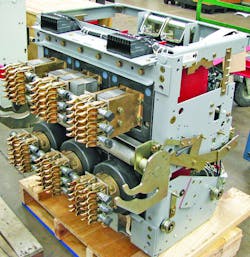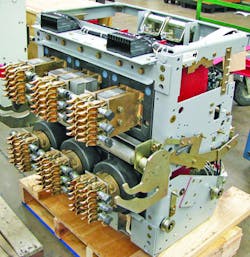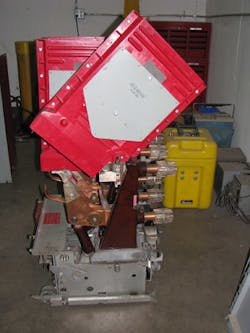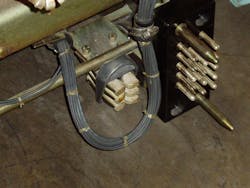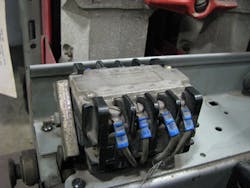The Basics of Circuit Breaker Maintenance
Circuit breakers are used in nearly all electrical systems — from residential dwellings to electric utility facilities. We rely on them to protect our systems from damaging overcurrents and short circuits. Understanding circuit breaker construction and operation is key to realizing their limitations and proper usage. This article covers basic components and operation of popular types of circuit breakers, including molded-case (MCCB), insulated-case (ICCB), low-voltage power (LVPCB), medium-voltage air-magnetic (MVACB), and medium-voltage vacuum (MVVCB) circuit breakers.
Key Components
MCCBs contain five components — a frame, operating mechanism, interrupting structure, trip unit, and terminal connections. These components are shown in Fig. 1.
-
-
Frame — houses and supports the components and also provides insulation to contain the arc.
-
Operating Mechanism — opens and closes the contacts.
-
InterruptingStructure — includes the arc chutes and all current-carrying parts except the trip unit. Arc chutes are designed to interrupt the arc quickly, usually 1.5 to two cycles for MCCBs and ICCBs.
-
Trip Unit — senses abnormal current flow and causes the operating mechanism to open the contacts. MCCB trip units are usually of the thermal-magnetic type.
- Terminal Connections — provides a suitable connection from the breaker to the conductor. Molded-case circuit breakers typically bolt directly to the bus.
-
Frame — houses and supports the components and also provides insulation to contain the arc.
Most manufacturers’ MCCBs have similar components and similar appearance.
ICCBs have the same basic construction as MCCBs, but use solid-state and digital trip units (as opposed to thermal-magnetic trip units) and have much higher interrupting ratings. ICCBs are often draw-out type, as opposed to bolt-in, although they can be either.
-
-
Disconnects or Stabs
- Main disconnects — connect the circuit breaker to the main bus.
- Secondary disconnects — connect the circuit breaker to the control circuits.
- Ground disconnect — connects the circuit breaker to the ground bus.
-
Contacts
- Arcing — transfers the arc to the arc runners in the arc chute.
- Main — carry the main load current.
- Auxiliary — make and break the control circuits.
-
Arc Extinguishers or Arc Chutes — interrupt and contain the arc.
-
Operating Mechanism — opens and closes the contacts.
- Overcurrent Trip Device — modern circuit breakers have digital trip units, although older units could be air dashpot or oil dashpot types. Typical functions are long-time delay (LTD), short-time delay (STD), instantaneous (INST), and ground fault (GF).
-
Disconnects or Stabs
Main Disconnects (stabs)
The main disconnects connect the circuit breaker to the bus. LVPCBs typically use either vertical or horizontal rows of straight, spring-loaded fingers to make contact with the bus bar, although on larger frame sizes they may have round or “tulip-style” disconnects. Photo 4 shows the backboard assembly of an LVPCB with primary, secondary, and ground disconnects clearly visible.
Most medium-voltage metal-clad circuit breakers will use “tulip-style” disconnects (Photo 5) and have some type of spring around them to ensure good contact with the bus. Medium-voltage, draw-out circuit breakers have the primary disconnects in the switchgear guarded by a shutter mechanism installed in the switchgear cubicle. As the circuit breaker is removed (racked out), the shutter closes. When the circuit breaker is racked into the “connected” position, the shutter opens, allowing the primary disconnects to make.
Secondary Disconnects (stabs)
The secondary disconnects bring power from the control circuits into the circuit breaker. Photo 4 shows an LVPCB and its secondary disconnects. The typical arrangement for this breaker is to connect and disconnect these stabs as the breaker is racked in and out of its cubicle. Photo 6 shows the typical arrangement for an MVACB, which often has to be manually connected.
Ground Disconnect (contact shoe)
Arcing Contacts
Arcing contacts are designed to prevent the main contacts from being damaged and can be made of alloys of silver, cadmium, tungsten, and zinc. The tungsten, cadmium, and zinc make the arcing contacts harder, so when the contacts open and close they will not deteriorate as quickly. When the circuit breaker opens, the main contacts part first and then the arcing contacts part, drawing the arc across them. When the circuit breaker closes, the arcing contacts make first, again drawing the arc across them. This prevents the main contacts from carrying the arc and preserves them.
The contact surfaces are shaped so that they have a rubbing motion, referred to as “wipe.” Wipe helps clean the contact surface, and is caused by one of the contact surfaces being contoured and the other surface being flat. When the contacts close, the contoured surface will have a wiping motion against the flat surfaced contact. Arcing contacts will usually have an arcing “horn” on the very top of the contact structure. The arcing horn aids in transferring the arc from the arcing contact to the arc runner in the arc chute.
Main Contacts
The main contacts are constructed of a softer alloy using less tungsten or zinc and more silver. They carry the load current, so they must have a lower resistance to current flow. The mains are larger, which also decreases their resistance.
Auxiliary Contacts
Arc Extinguishers
Arc extinguishers (arc chutes) contain the arc, stretch it out, cool it, and deionize it. This occurs within one-tenth of a second or less and is critical to safe operation of the circuit breaker and power system. The time it takes to interrupt an arc is known as the “maximum total clearing time” — the time from the start of the arc until it is completely extinguished. This characteristic is used to properly coordinate power systems so they will trip in the right sequence (selective tripping). Selective tripping is also referred to as “power system coordination,” as the devices will operate in their proper sequence when this is performed correctly.
When the contacts begin to open, the hot arc will rise. Most air circuit breakers will have their arc chutes positioned above the contact assemblies, as the natural tendency of the arc is to rise and aid in extinguishing the arc. The arc is hurried along the process by various components in the arc chute, such as puffers, blowout coils, arc runners, and arcing horns. There are exceptions to this arrangement. One manufacturer’s breaker positions the arc chute to the rear of the breaker.
Photo 11 shows an arc chute arrangement on an air-magnetic circuit breaker. Photo 12 shows the detail of a blowout coil assembly of a circuit breaker. The blowout coil is energized when the contacts part, forcing the arc current through them. This creates a magnetic field that pulls the arc into the arc chute more quickly.
Vacuum Bottles
An alternative that has virtually replaced MVACBs is the MVVCB. Vacuum circuit breakers interrupt the arc by denying it air. In a pure vacuum, there can be no arc. Even though the vacuum in vacuum bottles is very good, it isn’t perfect — so some arcing does take place. The arc is interrupted very quickly, usually in two to three cycles, depending on the application. Photo 13 is a vacuum bottle cut-away to show its components.
Vacuum bottles require very little maintenance when compared to air-magnetic contact assemblies. The contact moves only about ½ in. in the vacuum bottle, and the opening springs are much lighter. This reduces wear on the assembly and also reduces the weight, because heavy metal supports and frame can be decreased. The primary components of a vacuum bottle include:
- Bottle —Made of extremely hardened ceramic or glass. The bottle must contain the explosive force of an arc.
- Flexible Metal Bellows — Soldered/welded to the moving contact stem, it maintains the seal between the moving contact and the bottle.
- Bellows Shield — Protects the metal bellows from the intense heat of the arc. Since the vacuum is not perfect, there will be some arcing inside the bottle.
- Contacts — No arcing and mains here, just one set of contacts. When an arc is interrupted, some of the metal is vaporized. Most recollects onto the contact surface, while some drifts toward the inside of the bottle.
- Metal Vapor Condensing (arc) Shield — Since some small quantity of the contact face does not recombine onto the contact face, it starts heading toward the bottle wall. The metal vapor condensing shield is designed so both ends are open and do not contact the bottle. Any metal vapor that drifts to it cannot make a short between the contacts.
Circuit breaker operation. Modern operating mechanisms are quick-make, quick-break. This means that the speed of contact operation is independent of the speed of the control handle. Operating mechanisms are also referred to as “stored energy” mechanisms, because there are both opening springs and closing springs. One set of springs usually has tension on it. For this reason, use extreme care when working on or near circuit breakers. They have heavy moving contact assemblies and powerful springs. If your hand was between the moving and stationary contacts when it closed, it could maim you.
Closing springs do not hold the contacts closed. Over a period of time, they would weaken, causing the contacts to bounce, vibrate, and burn. The contacts are held in the closed position by a prop and roller operating mechanism. The prop and roller puts the contact linkage into a mechanical bind, forcing the contacts to stay tightly closed. A typical prop and roller mechanism is illustrated in Figs. 2, 3, and 4.
Figure 2 shows an operating mechanism in the “closed” position. The insulated coupling (12) holds the contacts closed due to parts 2, 5, 6, 11, and 14 being placed in an interference fit. The trip latch (11) holds the secondary latch (14) from rotating clockwise. The secondary latch is positioned against the secondary latch roller (6 – yellow), which in turn extends the cam (main) roller (5 – red) against the prop (2). The opening spring (15) is not shown in this view, but is exerting pressure on the contacts to open.
Note that the secondary latch (14) is held against the secondary latch roller (6), which is pushing the main roller (5) and its linkage into a vertical position. The main roller is in turn held against the Prop (2), which prevents it from overextending. The centerline of the insulating coupling pin is in a straight line with the main roller through the camshaft. In this position, the contacts are unable to open until the linkage collapses, which cannot happen until the trip latch (11) releases the secondary latch (14).
Figure 3 shows the same mechanism in the “tripped” position. To open the breaker, the trip latch is rotated clockwise, allowing the secondary latch to rotate counter-clockwise. When it does, the main roller (5) and the secondary latch roller (6) collapse. This allows the opening springs to pull the contacts open. Part 7 is a bell crank lever, which is used to change motion in one direction into motion in another direction. As the linkage collapses, the bell crank rotates, allowing the contacts to open.
Figure 4 shows the mechanism in the “reset” position. This position is the condition of the mechanism just before closing. The trip latch (11) and the secondary latch (14) are reset to the same position as when the breaker is in the “closed” position. To put the mechanism in this position, the cam (3) has to be rotated slightly counter-clockwise until the prop (2) is lifted up, allowing the main roller (5) and linkage (green) to slip into the crook of the prop. By doing this, the linkage is slightly extended, and the secondary latch (14) engages the front of the frame, as shown (in blue), which allows a gap between the trip latch and the secondary latch. The prop and cam reset to their original position, and, if the breaker close button is pressed, the closing springs will accelerate the contacts closed. The cam and prop will rotate, extending the linkage and forcing the components into the same positions as shown in Fig. 2.
In Summary
Circuit breakers are important for preserving the electrical system during abnormal conditions as well as protecting workers’ lives. Note the number of rollers and bearing surfaces in the operating mechanism. These require lubrication and, as the circuit breaker is in service, that lubricant dries out and becomes gummy. This slows the circuit breaker down, changing its operating speed. It’s important to note this change in operation speed will alter the results of a previously performed arc flash study.
White is director of training for Shermco Industries in Irving, Texas. He can be reached at [email protected].
